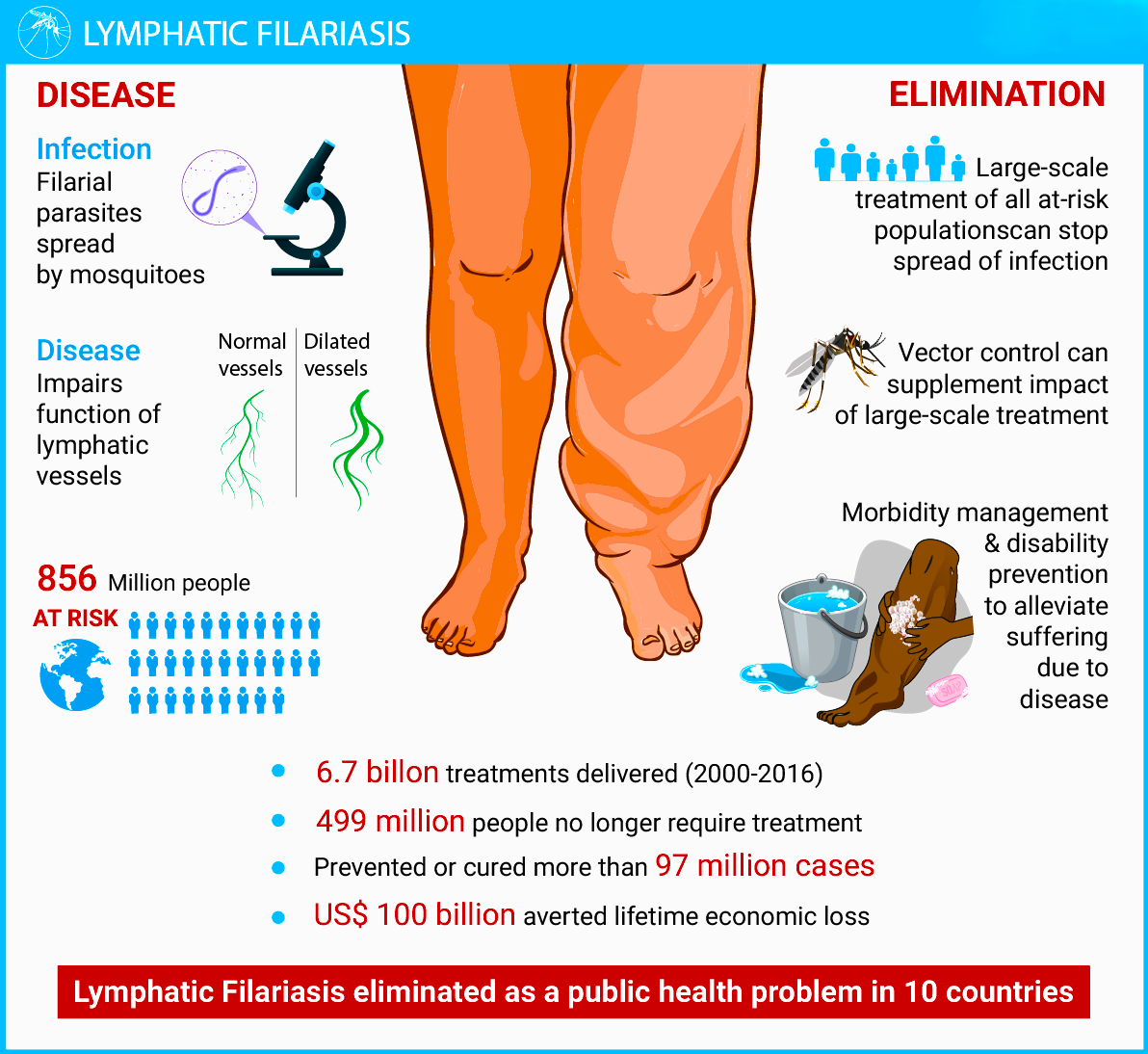India has launched a nationwide Mass Drug Administration (MDA) campaign targeting 111 endemic districts across 13 states.
- The initiative aims to eliminate Lymphatic Filariasis (LF) by 2027 through preventive measures.
About Lymphatic Filariasis

- Lymphatic Filariasis is commonly known as “Hathi Paon” or Elephantiasis.
- It is classified as a Neglected Tropical Disease (NTD).
- Causal Agent: Lymphatic Filariasis is caused by parasitic nematodes (roundworms) of the family Filariodidea.
- There are three types of filarial worms responsible for the disease:
- Wuchereria Bancrofti: Responsible for 90% of cases.
- Brugia Malayi: Causes most of the remaining cases.
- Brugia Timori : Also contributes to the disease.
- The infection is typically acquired in childhood and causes hidden damage to the lymphatic system.
- Transmission Cycle: Adult worms reside in the lymphatic vessels and produce microfilariae that circulate in the blood.
- Mosquitoes become infected when they bite an infected host, allowing the larvae to develop and spread to humans through subsequent mosquito bites.
- Impact of Lymphatic Filariasis: The disease leads to severe physical disabilities and long-term health consequences.
- It causes lymphoedema (swelling of limbs) and hydrocele (scrotal swelling), significantly impacting the quality of life.
Enroll now for UPSC Online Course
Neglected Tropical Diseases (NTDs)
- Definition: NTDs are a diverse group of conditions caused by viruses, bacteria, parasites, fungi, and toxins. They lead to severe health, social, and economic burdens, mainly affecting impoverished tropical communities.
- Global Impact: Over 1 billion people are affected, with 1.6 billion requiring interventions for prevention and treatment.
- Examples of NTDs:
-
- Bacterial: Leprosy, Trachoma
- nya, RaParasitic: Lymphatic Filariasis, Schistosomiasis
- Viral: Chikungubies
- Fungal: Mycetoma
- Toxin-related: Snakebite Envenoming
|
India’s Status on Lymphatic Filariasis
- About 31 million people are estimated to be harbouring microfilaria (mf) and over 23 million suffer from filaria disease manifestations.
- 90% of India’s LF burden is concentrated in eight states: State of Bihar has highest endemicity (over 17%) followed by Kerala (15.7%) and Uttar Pradesh (14.6%).
- Andhra Pradesh and Tamil Nadu have about 10% endemicity.
- The Indian government aims to eliminate Lymphatic Filariasis by 2027 through a combination of:
- Mass Drug Administration (MDA).
- Morbidity management.
- Vector control strategies.
About Mass Drug Administration Campaign
- The MDA campaign involves the supervised administration of a combination of anti-filarial medicines to all eligible individuals in Lymphatic Filariasis (LF)-endemic areas.
National Center for Vector Borne Diseases Control
- The National Center for Vector Borne Diseases Control is an umbrella program focused on preventing and controlling vector-borne diseases.
- It works to combat various vector-borne infections, including:
- Malaria
- Japanese Encephalitis
- Dengue
- Chikungunya
- Kala-azar
- Lymphatic Filariasis
- Vector-borne diseases are infections transmitted to humans and animals through bites from blood-feeding insects such as mosquitoes, ticks, and fleas.
|
Check Out UPSC CSE Books From PW Store
- Medicines are provided regardless of whether individuals show symptoms, ensuring widespread preventive coverage.
- The MDA campaign follows two drug regimens for treatment:
- Double Drug Regimen (DA) : A combination of Diethylcarbamazine Citrate (DEC) and Albendazole.
- Triple Drug Regimen (IDA): A combination of Ivermectin, Diethylcarbamazine Citrate (DEC), and Albendazole.
- Implementing Agency: The National Center for Vector Borne Diseases Control (NCVBDC) is responsible for leading the implementation of the MDA campaign.
- Ministry in Charge: The Ministry of Health & Family Welfare oversees and supports the execution of the campaign.
- Objective of the MDA Campaign: The primary goal is to eliminate Lymphatic Filariasis (LF) from 111 endemic districts across 13 states.
- The campaign aims to eliminate microscopic filarial parasites present in the bloodstream of infected individuals, thereby preventing further transmission.
Ready to boost your UPSC 2025 preparation? Join PW’s UPSC online courses today!
![]() 12 Feb 2025
12 Feb 2025


